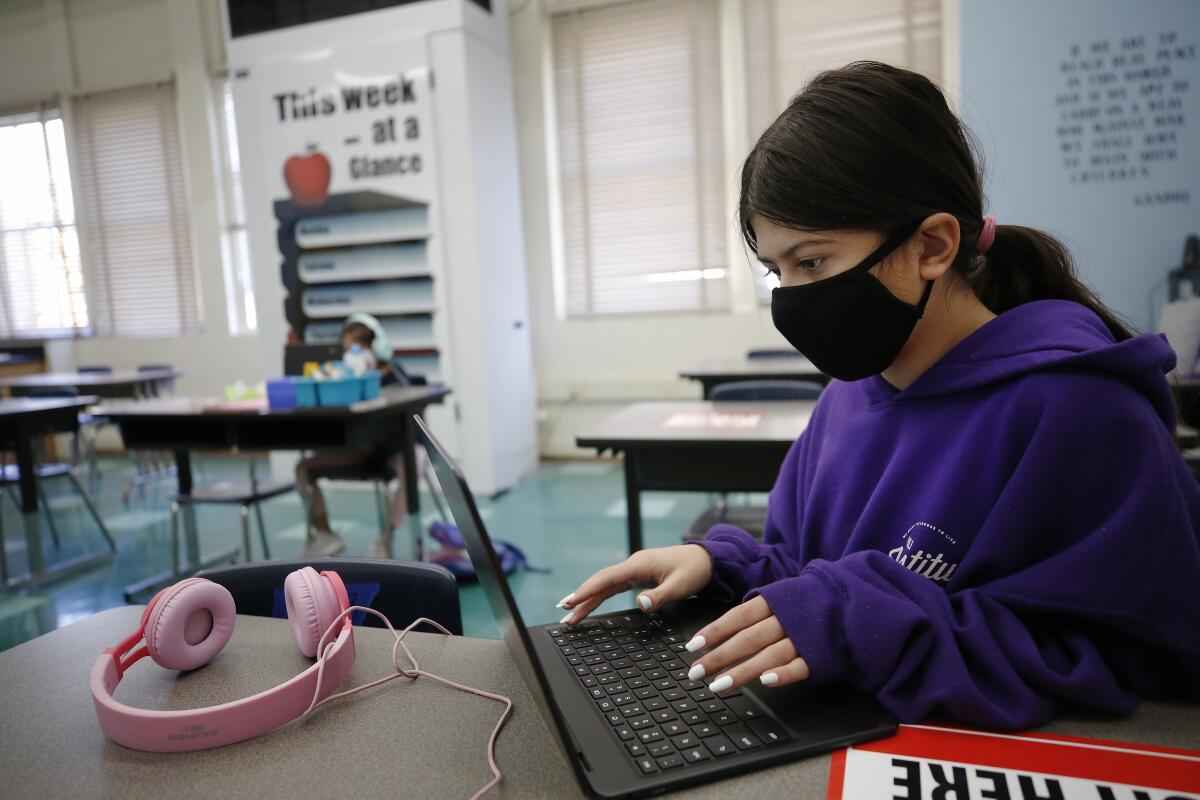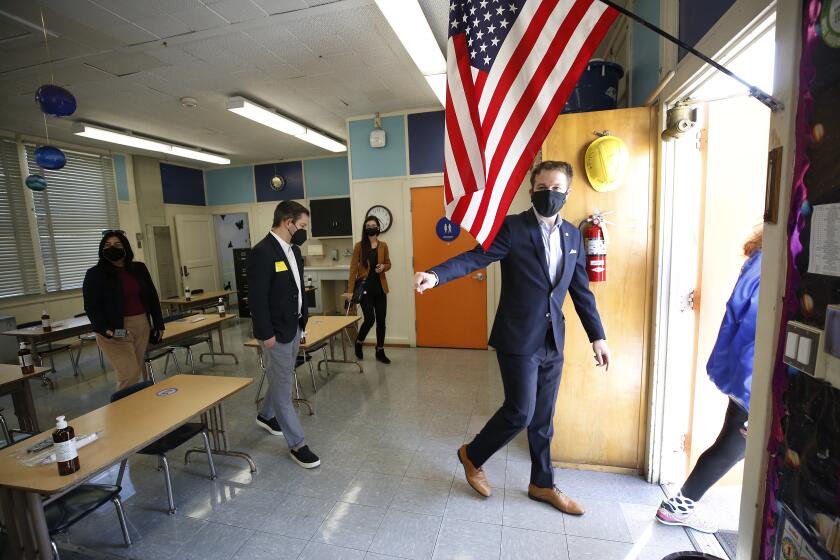LAUSD students suffered ‘alarming’ academic harm during pandemic, report says

- Share via
Students at all levels have suffered academically since the Los Angeles Unified School District closed its campuses more than a year ago, with the greatest harm falling on younger ones and those who were faring worse before the pandemic, a new report has concluded.
“We may not know the full impact of this last year on our students for another year or more, but the preliminary data we have paints an alarming picture,” says the report, titled “Educational Recovery Now” and released Wednesday by Great Public Schools Now, a local advocacy group.
While the report avoids assigning blame, it paints a sobering picture of student learning that L.A. Unified must prevent from worsening, the authors said.
The district is headed toward a gradual reopening of campuses beginning the week of April 12.
The report relied primarily on data released piecemeal by L.A. Unified over the past year and includes commentary by Pedro Noguera, dean of the USC Rossier School of Education, and Magaly Lavadenz, executive director of the Center for Equity for English Learners in the School of Education at Loyola Marymount University.
“Most students in the district have experienced learning loss, and school closures have deepened and accelerated existing inequities,” the authors wrote. “While attendance and engagement has improved since spring 2020, many students are still not actively engaging, and large gaps across race, income and student need persist.”
The L.A. Unified administration declined to respond to the report.
In previous depictions of the district’s pandemic response, L.A. schools Supt. Austin Beutner has focused on what the nation’s second-largest school system has achieved, including an expansive program to provide free meals to the community, a coronavirus testing program and the deployment of district computers to 465,000 K-12 students, as well as internet hot spots upon request. The report noted these actions, as well as “Herculean” efforts by many teachers.
“A lot of the conversation over the last year has been focused on the safety of our campuses and operations. We haven’t really heard a lot about what the instructional plan or vision is this school year and moving forward as we head into recovery,” said Ana Teresa Dahan, a senior director for the advocacy group, who helped prepare the report.
The theme of the moment is that L.A. schools are safe — but it’s hard to turn on a dime after months of a contrary message.
The report focused on academic efforts and measures during the pandemic, finding that:
- More than 13,000 middle and high school students consistently disengaged in fall 2020. An additional 56,000 did not actively participate on a daily basis.
- Two in three students are falling behind in literacy and math.
- Black and Latino students have been disproportionately affected.
The report states that Black and Latino elementary school students fell the furthest behind, with only 43% of Black students and 44% of Latino students on track in early reading skills, according to literacy assessments from the fall.
Like other school systems, L.A. Unified has had to contend with factors beyond its control, including the trauma of families from low-income communities disproportionately harmed by COVID-19 and economic hardship. Although many district-distributed hot spots provided spotty service, poor signal strength in low-income communities and the need for all families members to be online at once contributed to connectivity problems.
The pandemic hit this Black family hard, medically and financially. A white couple has adapted, and thrives.
But the report singled out missed opportunities, saying, for example, that the district could have more thoroughly assessed academic needs as it prepared for the fall reopening.
“The consequence of moving into the fall semester without an understanding of students’ academic and social-emotional standing after several months of missed learning time in the spring is that the district missed a major opportunity to establish a concrete plan to address engagement problems and the learning losses accumulated from the spring,” the report stated.
School board member Nick Melvoin, who reviewed the report Tuesday, added a disappointment of his own: In the fall, in-person assistance to students with special needs reached fewer than 1% of district students.
“This report highlights the unfortunate if unsurprising reality that the pandemic has massively and unevenly disrupted student learning and well-being, which is why the district embraced its role as a social safety-net provider, and why I’ve been advocating for months to provide additional services, including in-person opportunities where possible, to support student learning,” Melvoin said.
The report also stated that the district’s distance-learning agreement with the teachers union provided for substantially less live online instructional time than did similar agreements among the state’s five largest school systems, including those of San Diego, Long Beach and Fresno. The amount of learning time for Los Angeles students is the subject of an ongoing lawsuit.
A decline in grades prompted the authors to raise a warning flag: “Within the next four years alone, 40,000 current LAUSD high school students or more are at risk and could potentially not earn their high school diploma.”
The report noted that the district established a low bar for student engagement.
“It is important to note that only a ‘click’ in the district’s online platform, Schoology, is necessary for LAUSD to count that student as engaged,” the report said. “This ‘click’ criteria is not a perfect measure of how students engage in distance learning, but even with that limited threshold for engagement, the gaps in engagement between student groups still indicate disparities in opportunities to learn.”
In the fall, about 20,000 students were missing three or more days of class each week. The numbers for early 2021 are slightly worse, the researchers wrote.
The goal of the report is “to start a public conversation on the impacts of a year without in-person instruction on our students, particularly those with the highest needs, and to call on LAUSD to develop a comprehensive educational recovery plan,” the authors stated.
The recommendations include learning from other school systems; prioritizing healing, mental health and connectedness; accounting for students with different needs, and forging a deeper partnership with families in developing and carrying out plans.
“I appreciate the urgent call for a comprehensive, measurable educational recovery plan,” said school board member Tanya Ortiz Frankin, “including collaborative public conversations with our families, educators, and partners about how to strategically and holistically support all students in the aftermath of this pandemic.
“I know that the best decisions are always made with those who are most impacted,” she added, emphasizing the word with.
“How do we approach the pandemic and recovery as an opportunity to rethink how we are serving students and meeting the goal of equity?” Noguera wrote in the report. “We cannot undo the past, but we can recover in a way that is truly different than the inequitable system we should leave behind.”
More to Read
Sign up for Essential California
The most important California stories and recommendations in your inbox every morning.
You may occasionally receive promotional content from the Los Angeles Times.












